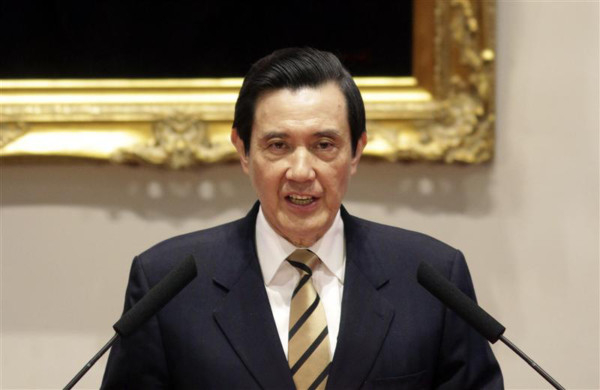
If you want a symbol of peaceful rebellion against the immovable force that is Beijing, your first thought may be the umbrella. The flimsy parasol, wielded by Hong Kong students to protect themselves against pepper spray and tear gas, has become symbolic of a civil disobedience campaign seeking more genuine democracy. Yet, the even more fragile sunflower may turn out to be a more lasting symbol of resistance. Taiwan’s so-called “Sunflower Movement”, which predated the “Umbrella Revolution” by six months, went largely unnoticed in the West. In scale and significance, however, Taiwan’s rebellion is arguably a more important thumbing of the nose at China’s Communist party.
In March, Taiwanese students occupied parliament, strewing the chamber with the sunflowers that gave the movement its name. At issue was passage of a seemingly innocuous services agreement, part of a much deeper trade deal between Taiwan and China known by the clunky acronym of Ecfa, or Economic Cooperation Framework Agreement. To many in Taiwan, deeply wary of China’s motives, the ever-closer trade ties enshrined in Ecfa are nothing more than a trap — a ploy to increase Taiwan’s economic dependence on the mainland, thereby drawing it ever closer into its net.
As in Hong Kong, in Taipei, there were confrontations with riot police, though in Taiwan some 150 people were injured. As in Hong Kong, the crackdown prompted an outpouring of public sympathy. Crowds in Taiwan, estimated by the organisers at 500,000, if considerably fewer by police, were certainly much larger than those that have flooded on to Hong Kong’s streets. Yet, the world barely noticed. Why? One reason is that Taiwan’s profile is not what it was. In the 1980s and 1990s, it was considered a “tiger economy”, lunging at breathtaking speed not only from poverty to wealth, but also from authoritarianism to democracy. More recently, as the economy has matured, Taiwan has fallen off the map.
The more important reason is that Taiwan is, mistakenly, no longer considered a dangerous flashpoint. Under Ma Ying-jeou, its President since 2008 and leader of the Beijing-leaning Kuomintang nationalist party, there has been what looks like a spectacular rapprochement with mainland China. Taiwan has dropped any suggestion that it may push for formal independence, something that for Beijing had been an alarming possibility under Ma’s predecessor, the “splittist” Chen Shui-bian. Beijing is committed to invading Taiwan should it ever take that drastic step. Ma’s more conciliatory stance has produced a dramatic easing of military tension across the Taiwan Strait. Taiwan and China opened their economies to each other’s goods and investment. Cultural links have also vastly improved. There are now hundreds of direct weekly flights linking Taiwanese and Chinese cities. Before Ma, there were none.
In Hong Kong, China’s growing influence is causing an existential angst that is the root cause of pro-democracy demonstrations. The same is true of Taiwan. In June, Zhang Zhijun became the first Chinese ministerial-level official to visit the island since the end of the civil war in 1949 when Mao Zedong’s Communists took control of mainland China and Chiang Kai-shek’s Kuomintang retreated to Taiwan. For his efforts, his entourage was pelted with paint.
The Taiwanese have been watching events in Hong Kong with rapt attention. From Taipei, Hong Kong can look like a cautionary tale: This is what happens if you are lured too close to Beijing’s flame. Even Ma had to draw a bold line in the sand when Xi Jinping, China’s President, picked last month — of all months — to press the virtues of Hong Kong’s “one country, two systems” on Taiwan. With thousands in Hong Kong protesting Beijing’s influence, Ma went on television to reiterate his policy of three Nos: No unification, no independence, no use of force. He went further by urging Beijing to allow full-fledged democracy in Hong Kong, even suggesting that it may not be such a bad thing for the mainland either.
For Beijing, this is deeply worrying. Hong Kong and Taiwan, which it regards as equally integral parts of its territory, are in differing degrees of revolt. So are Xinjiang and Tibet, where terrorist attacks and self-immolations have become all-too regular occurrences. Xi is reputed to be China’s strongest leader since Deng Xiaoping, if not Mao. Yet, when it comes to China’s periphery, he can just as easily be seen as losing his grip. As John Garnaut, a China expert, wrote recently, this undermines the story of China as “an inexorably rising power”. Even as Beijing presses home its territorial claims in the East and South China seas, and expands its commercial influence as far afield as Africa and Latin America, territory it considers unambiguously Chinese is squirming out of control.
Beijing’s plan to lure Taiwan into its embrace risks backfiring. Taiwan’s voters may even throw the Kuomintang party out in 2016, replacing it with an opposition Democratic Progressive party that has a much stronger pro-independence streak. That could set Taiwan on a collision course with Beijing once again. Jerome Cohen, a lawyer who specialises in China and Taiwan, says the world has been lulled into a false sense of complacency over the Taiwan Strait. In a few years, he predicts, the “Taiwan problem” will be back.
— Financial Times









